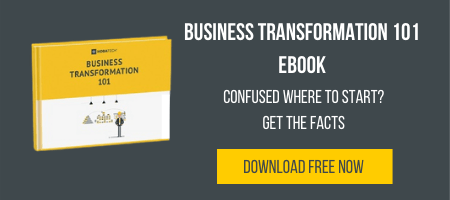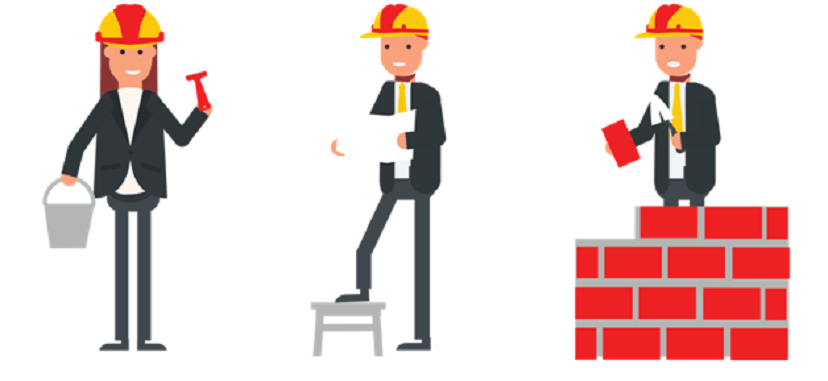The ongoing COVID crisis has hit the business community hard, as the entire corporate landscape has drastically changed with employees now working from home. This shift to the Work from Home model has forced businesses to reevaluate their ways and think out-of-the-box to move forward. Plus, the high-level of competition has made it even harder to please the consumers -with innovation lying at the core of most products today.
In order to make sure you reach product-market fit for your product or service (including your TOM), you need to bring differently-skilled people together.This is where Business Design Collaboration comes in. It is a smart and pragmatic approach that helps numerous talented individuals come together to produce something extraordinary.
In this practical guide, I will be discussing what business design collaboration means, how it can help businesses craft compelling products and experiences, and how you can nurture an environment that promotes collaboration along with the tools and the processes needed to achieve a seamless transformation.
What Does the Term ‘Business Design Collaboration’ Mean?
Anyone can make a great product or service, but to create an extraordinary one, you need to collaborate and connect all the creative minds together. This involves hand-picking the best and uniquely skilled individuals, belonging to varying fields such as architecture, design, development and implementation, and bringing them together to work on one single product to achieve groundbreaking results – faster than ever! These experts could be architects, designers, marketers,product and project managers, etc. The collaborative process is a multi-staged technique that revolves around feedback – in fact, it thrives on feedback!
There’s no current rule that says you can’t design or create a product without incorporating a design collaboration methodology,but without collaboration, will you really have something innovative? And this pandemic has practically forced businesses to evolveand innovate in order to survive.
Whether it is a new product or a complex internal system, when great minds work together – you have the ability to achieve the unthinkable. The experts can leverage this opportunity to use their unique perspectives and work collectively to resolve customer concerns and fulfill newly formed objectives (thanks or no thanks to COVID, depending on how you look at it) – making it easier to achieve the Target Operating Model(TOM) through a new and enhanced framework.
What Does it Entail?
An effective Business Design is essentially an advanced human-centric approach to developing and implementing designs and plans that help the business create real-value and gain competitive advantage. It combines the main pillars that make or break a business – Customer Experience(CX)and Business Design– keeping the interest of the customer at heart. It involves lots of testing, experimentation and feedback (lots of it!).
There are four (4) key activities of effective business design-
- Documentation,
- Workshop facilitation,
- Project Management, and
- Sign-off
The first step always starts with “Keeping The End In Mind” (i.e. knowing what the end looks like). To do that, you start off with a blueprint – of the Target Operating Model – that lists the company’s entire resources (internal and external) needed to bring your vision to fruition. This acts as a checklist of what you know and have, and what you need to develop – whether its to buy, build or borrow to bring your product or service to market.
From your checklist, you assign the tasks and actions to the team, proving them the tools to work collaboratively to achieve their objective and share the vision with the stakeholders (workshop facilitation). You hold focused sessions to build concrete goals, define the requirements and the ultimate actionable plan. Project Management plays a crucial role here in helping the manage the team to reach its goals within the allocated time.
The final design sign off and approval by clients and stakeholders helps kick-start operations in full swing – You may want to have a look at this comprehensive guide that I created on effective business design and its key components.
The design collaboration process can be broken down into four (4) main stages:
- Brainstorming
- Research
- Getting Feedback
- Client feedback
We will be discussing these in detail in ‘the Process’ section below.


Can All Businesses Benefit from Design Collaboration?
Yes, collaboration (which is a key player in this) brings about the best results for everyone! Whether you’re rebranding your business, building an app or working on creating integral internal systems, only a collaborative approach will bring the best results. In fact, despite popular belief, it is the only way in this current business climate when businesses are redefining their strategiesto create a robust TOM to achieve your new business goals.
However, here lies the problem – communication. Communication (or unclear and ambiguous communication) is be a huge problem for many businesses today – making proper collaboration (not just giving it ‘lip service’) in any environment, even worse in the current – COVID – work from home environment!
However, if HelpScout can build an amazing remote culture and our perform its competitors, so can you! With employees in 50 different countries, they have managed to boost collaboration through the smart use of technology and pull the team and business through these tough times and exceed customer and market expectations.
How to Build an Environment that Promotes Effective Design Collaboration?
Does it seem impossible to fit ‘collaboration’ into the equation when working from home? One of the greatest challenges facing businesses right now is how to boost collaboration and communication.
Nevertheless, the pandemic shouldn’t hold you back from uniting and achieving extraordinary results.When done right – using the right tools and processes – you can implement and embed business design collaboration better than ever before. With so many fantastic tools at your disposal, breaking the barriers has never been easier! In fact, these tools can help you better facilitate your agenda – without the use of paper!
Here is a list of tools to use to facilitate better and enhanced interactions at your (virtual) workspace.
Tools that Can Help You:
Both are designed for Project Managers to seamlessly manage their teams, assign work, and provide feedback – all in one convenient space. The difference between the two is simple – Asana displays Kanban boards through cards and columns, allowing visual tracking of each project. Whereas Jira comes with the Kanban and Scrum boards that are perfect for agile teams willing to track their work based on sprints.
Perks:
- Helps reduce clutter and chaos – making it easier to achieve deadlines with constant updates.
- Integrates with all your files for extensive collaboration (Dropbox, Google, etc.)
- Improved efficiency and management of work (and teams) through instant messaging.
Usage:
Lifeblood for Project managers to manage teams, and not just remote teams.
Mural:
Mural streamlines your collaborative processes by offering an (almost) fully interactive whiteboard session with your team to share and work on ideas with extensive file-sharing capabilities.
Perks:
- Interactive whiteboard to pitch in ideas and provide feedback
- Anonymous sign-in to hide your identify on ‘sensitive’ subjects
- Beautifully designed UI, appealing to both technical and non-technical stakeholders
Usage:
Perfect for collecting team feedback during workshop facilitation sessions or when explaining the documentation. You could also use Zoom for that, but Zoom has limited white boarding capabilities.
Figma:
You’ve done the white boarding sessions, now you need to design the UI or knock up a quick prototype to show your stakeholders what the new UI or User Experience (UX) would like that – now guess what? Yes – “there’s an App for that”!
Figma is a renowned shared workspace tool that enables multiple individuals to work on the same UI design file. It offers real-time design editing – making it easier than ever to collaborate.
Perks:
- No isolated work sessions
- No need for static deliverables to collaborate. You don’t need to amend anything to showcase your design, as everything is transparent.
- A user-friendly interface makes it easier to play with the design when and as needed.
Usage:
Figma comes in handy during any last-minute changes or when receiving feedback during the research, design and final feedback stages of the design collaboration process. It is the tool to craft your design in real-time – as it allows continuous feedback. With the ongoing feedback, you can easily and quickly make amendments.
Other CollabTools:
Dropbox Paper:
You’ve done your work shopping, white boarding and rough designs, but where do you store them, you need a repository to check files in and out. Use Dropbox Paper to share files, work on-the-go and while offline, making sure nothing is lost along the road.
Share Point:
No list of collaboration tools would be compete without this staple, usually the go-to for documentation storage (along with G-Drive, and Google Docs – if your organisations allows it, but with its questionable data/security but both anecdotally having synchronizing issues of late, there are better tools on the market).
Slack:
Forget email, simplify work communications (and file sharing). Create your own Slack workspace chat room – separate channels for separate conversations. No more combining emails with 2+ subjects and losing the trail. You could also use Skype, but is not as strong for Teams or written communication.
The Process
Now,here’s a quick glimpse how you can make the business design collaboration process work for you:
Brainstorming Ideas Together
There are numerous ways you can eliminate the need for physical, face-to-face interactions when working from home. For virtual collaboration to work, you first need to define your “ways of working” and that includes – working hours for your employees, which may include different starting times as most of us are working from home now are also dealing with domestic routines.
For those working across time zones, you need and sync the time zones (Google or Mac Calendar has ‘time zone’ assist feature to help here). Use screen–sharing, video calls, whiteboard and digital post-its on Dropbox Paper for visual presentations you used to have face-to-face.
To make things fun and interesting, incorporate virtual coffee catch-up sessions into your weekly routine – these work as short breaks from work while boosting team morale and collaboration.
Carrying Out Research
This step entails the use of questionnaires, surveys, polls, etc., to get customer/stakeholder insights. Use Google Forms, Type Form or Survey Monkey to create engaging polls. This helps keep the customers/stakeholders in the loop and a sense of inclusion – which enables you to get insights from actual stakeholder feedback and design a TOM that is truly fit for purpose. Don’t forget to look at competitors and examples outside of your industry, and look for trends and evaluate how you can incorporate those changes to make your product stand out.
Getting Feedback
Remember – Feedback is crucial for this to work! Carry out daily video walk-throughs – better than in-person meetings – to make sure staff and clients (whether internal or external) are on the same page! For work-in-progress, use Dropbox Paper (or Figma– depending on what stage you are at), to show how the design has evolved taking them on the ‘transformation journey’ with you.The benefits of these tools is real-time edits are captured (as well as the history to see the changes and feedback has been incorporated). This also supports your agile development methodology – as you can quickly adapt your design according to the feedback.
Final: Client Feedback
The last step is about giving your clients a final walk through of the ultimate program/service/product, but if we’re honest, its never final. It’s the ‘final’ for this phase, and the product and service (and TOM) will evolve overtime. You want to get agreement now of what the ‘final’ version today looks like, agree final changes and implement.Once the client or stakeholder(s) sign it off – its time to celebrate! Complete the implementation and get ready to iterate, because that is what being ‘agile’ is about.. iterate, iterate, iterate!
Do you want to learn about Business Design Collaboration in developing your TOM so you don’t waste time and money on using old techniques that don’t work? Drop a comment below and I’ll invite you to my free FB group!
Thank you for reading this!
Sincerely,
Heath Gascoigne
P.S. If you want to learn more about Business-led digital transformation, check out my book The Business Transformation Playbook here.
For more information, visit https://hoba.tech/














